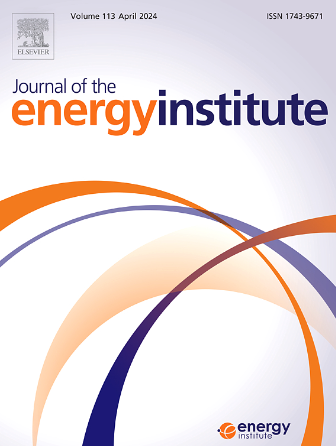Highly selective catalytic transfer hydrodeoxygenation of lignin-derived phenols over carbon-encapsulated cobalt catalyst
IF 5.6
2区 工程技术
Q2 ENERGY & FUELS
引用次数: 0
Abstract
The catalytic transfer hydrodeoxygenation (CTHDO) technology of lignin-derived bio-oil is a very promising bio-oil conversion technology. However, the preparation of highly active and stable catalysts remains a major challenge. Carbon-coated metal nanoparticle catalysts can effectively solve the problems of catalyst deactivation and high-temperature metal leaching. In this work, a series of MOF-derived carbon-coated Co-based catalysts were designed via a simple solvothermal method using terephthalic acid as organic ligands, which were applied for the CTHDO reaction of guaiacol using isopropanol as H-donor. Among them, Co/C-2-500 had the best catalytic performance for the conversion of lignin-derived phenol to cyclohexanol. Under the optimal conditions of 180 °C, 0.5 MPa N2, and 3 h, the conversion rate of guaiacol can reach 100 %, and the yield of cyclohexanol can reach 96.8 %. Mechanism research showed that the phenol generated from the demethoxylation of guaiacol was a key intermediate, which further underwent the hydrogenation of aromatic ring to form cyclohexanol. Based on the various characterizations, it can be considered that the high catalytic activity was due to the synergistic effect of the metallic Co0 active sites and the acid sites. This research could provide some insights for the catalytic transfer hydrodeoxygenation of lignin and its derivatives.
木质素衍生酚在碳包覆钴催化剂上的高选择性催化转移加氢脱氧
木质素生物油催化转移加氢脱氧(CTHDO)技术是一种极具发展前景的生物油转化技术。然而,制备高活性和稳定的催化剂仍然是一个重大挑战。碳包金属纳米颗粒催化剂可有效解决催化剂失活和高温金属浸出问题。本研究以对苯二甲酸为有机配体,采用简单的溶剂热法设计了一系列mof衍生的碳包覆co基催化剂,并将其应用于异丙醇为h给体的愈创木酚的CTHDO反应。其中,Co/C-2-500对木质素衍生苯酚转化为环己醇的催化性能最好。在180℃、0.5 MPa N2、3 h的最佳条件下,愈创木酚的转化率可达100%,环己醇收率可达96.8%。机理研究表明,愈创木酚脱甲氧基化反应生成的苯酚是关键中间体,其进一步发生芳香环加氢生成环己醇。根据各种表征,可以认为高催化活性是由于金属Co0活性位点与酸位点的协同作用。本研究为木质素及其衍生物的催化转移加氢脱氧提供了新的思路。
本文章由计算机程序翻译,如有差异,请以英文原文为准。
求助全文
约1分钟内获得全文
求助全文
来源期刊

Journal of The Energy Institute
工程技术-能源与燃料
CiteScore
10.60
自引率
5.30%
发文量
166
审稿时长
16 days
期刊介绍:
The Journal of the Energy Institute provides peer reviewed coverage of original high quality research on energy, engineering and technology.The coverage is broad and the main areas of interest include:
Combustion engineering and associated technologies; process heating; power generation; engines and propulsion; emissions and environmental pollution control; clean coal technologies; carbon abatement technologies
Emissions and environmental pollution control; safety and hazards;
Clean coal technologies; carbon abatement technologies, including carbon capture and storage, CCS;
Petroleum engineering and fuel quality, including storage and transport
Alternative energy sources; biomass utilisation and biomass conversion technologies; energy from waste, incineration and recycling
Energy conversion, energy recovery and energy efficiency; space heating, fuel cells, heat pumps and cooling systems
Energy storage
The journal''s coverage reflects changes in energy technology that result from the transition to more efficient energy production and end use together with reduced carbon emission.
 求助内容:
求助内容: 应助结果提醒方式:
应助结果提醒方式:


